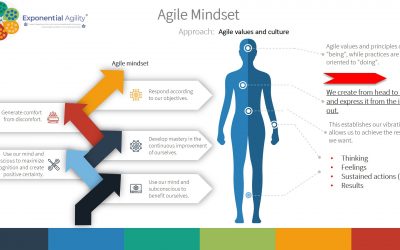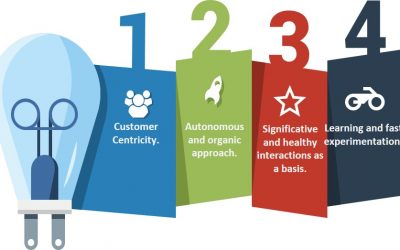
Before agile leadership, it is necessary to be multiplying leaders and executives, who are consistent, inspire and do not postpone the execution, pulling from the development of our collaborators, all the time.
During our professional development, we must be very aware that we achieve our results through influencing other people, we do not achieve them independently, so we must focus on others and the positive impact of our actions and experiences that we make them live, it is impossible for someone to believe that they know you, that they think you are the person you were 15 years ago and that your changes have been microscopic, it is naive, even more so when you have never interacted personally or professionally with that person. In short, this serves as a prelude to this important topic of today, executive leadership and multiplier represents an evolution and a multiplication of your person, as executive leader.
The managerial skills of an executive leader are focused on generating habits of a consistent set of actions.
We can highlight these skills in three relevant verticals, the first is direction, we need to know as an organization where we are going, and where we are, so how we can close this gap, the second is commitment, always be clear about the positive impact of what I am doing, the third is execution, things can always be difficult, especially when we are introducing changes in a company.
In the direction vertical, we find three basic skills that I would like to highlight, the first is strategic thinking, how we leverage our basic skills to obtain the best decisions, which consists of generating habits for disciplined thinking of the future, beyond our tasks and equipment. What would I do if I would represent my competition? What would I do if this technology or way of thinking dominates the market in a few years? What type of new generation services should I create to be a leader in a market or sector? How should I think to take advantage of always learning first? Should I disrupt myself? The answer to these questions can help us put our thinking in perspective. The second skill is, purpose and vision, to establish a transformative and massive purpose, that describes a better future for our company, industry and / or community, that allows to give cohesion to these players from an internal and external perspective, being a shared purpose based in values and integrity, not only in external actions. The third skill is focus, in the face of uncertainty and significant risks, choosing a course and acting with courage and bravery, making decisions that others avoid, for this we must challenge our way of thinking, our hypotheses, our lessons learned, we need to be prepared to unlearn.
Let’s remember that the success of other people is our success, always taking into account abundant and exponential thinking, focused on positively impacting people.
In our second vertical we find, commitment, in this vertical our first ability is the executive presence, which is made up of passion, emotions, thoughts and actions, remember where we focus energy, results are concentrated. If we deliberately align passion, emotion, thought and actions and focus on them in a sustained way, we will have desired results.

Our second skill is talent management, remember to increase talent, talent must be managed with talent, as we help our collaborators to establish priorities to increase their skills and abilities, remember that if we take care of them, they will surely take care of our clients, implies establish an organization in reverse, where the action decision is made by our players A and B, as Jack Welch said.
Our third skill in this vertical is communication, what are the 3 most important things I want to take away from all this and in turn want to communicate clearly? Executive leaders are simplifiers, simple, it does not just mean being concise, it’s systematizing and framing the complex into significant elements. Let us remember that we want to transmit the relevant in a clear, brief and memorable way. It’s a skill that we must also teach our collaborators and work teams.
Let us focus our energy on thinking and feeling, what are the 3 relevant things that we want to transmit? To be understood, remembered with precision and inspiration.
Finally, we have our execution vertical, situations are always present in a moving environment and where we are building totally new things, I remember once a manager, who was recently in the workplace, where there were about 50 teams, he made a brief comment to me: “How are you? I am not very well, I cannot concentrate, to which I asked him why he felt this way, he replied: There is a lot of dynamism in this place, I do not have a closed office, everyone asks me questions and there are many situations to solve, tomorrow I will work from the central office, here I cannot work. The dance floor as many of us call it is like that every day, going up to the balcony is necessary to have the complete picture, but going down to the dance floor makes you face and deal with reality every day.
Our first skill here is prioritization, for which we must establish and always keep in mind our definition of value, what is it that gives value to the business without which it would not be possible to do it ?, in such a way that we co-create it with our team of collaborators, let us be persistent prioritizers, focus our energy on the 3 most relevant priorities, which must be clear and explicit, which is the minimum required to deliver value, let us focus our collaborators on what to do and what not to do.
Always remember, start small and look big, to build our results in an iterative, incremental and emergent way.
Our second ability from this vertical is responsibility, which we translate here as progress in our shared purpose, must be stimulating, fulfilling, and a source of pride. Let’s focus on building trust and supporting impediment removal. Let’s focus on the cadence of the sessions to manage results and expectations, let’s remember our priorities, autonomy based on mastery, purpose and meaning, to generate better results.
Our third skill is experimentation, it is recommended to create and implement an innovation framework from the executive level, which promotes experimentation and rewards levels of achievement, our job as leaders is to create frameworks to give value across the board to the organization and customers.
Before agile leadership, we must be multiplying leaders and executives, who are consistent, inspire and do not postpone execution, pulling the development of people all the time.
Miguel Martínez, July 2020.
I recommend below some extraordinary books, the first, the second and the seventh are great !!, obligatory and recommended readings of this exciting topic.
Bibliography:
- Avery, C. M. (2016). The responsibility process: Unlocking your natural ability to live and lead with power. Pflugerville, TX: Partnerwerks, Incorporated.
- Koestenbaum, P. (2010). Leadership: The inner side of greatness: A philosophy for leaders. San Francisco, CA: Jossey-Bass.
- Wiseman, L., & Tato, A. M. (2019). Multiplicadores: Cómo potenciar la inteligencia de tu equipo. Miami, FL: Penguin Random House Grupo Editorial.
- Koning, P. (2020). Agile leadership toolkit: Learning to thrive with self-managing teams. Boston: Addison-Wesley.
- JOHANSEN, B. (2017). NEW LEADERSHIP LITERACIES: Thriving in a future of extreme disruption and distributed everything. Place of publication not identified: READHOWYOUWANT COM.
- Blanchard, K. H., & Broadwell, R. (2018). Servant leadership in action: How you can achieve great relationships and results. Oakland, Ca: Berrett-Koehler ,, a BK Business book.
- Hamman, M., & Cooney, L. (2019). Evolvagility: Growing an Agile Leadership Culture from the Inside Out. Lopez Island, WA: Agile Leadership Institute.
- Peterson, J. (2020). Entrepreneurial leadership: The art of launching new ventures, inspiring others, and running stuff. Nashville: HarperCollins Leadership.
- Coriat, B., & Domínguez, R. A. (1992). Pensar al revés: Trabajo y organización en la empresa japonesa. México, D.F.: Siglo Veintiuno.



